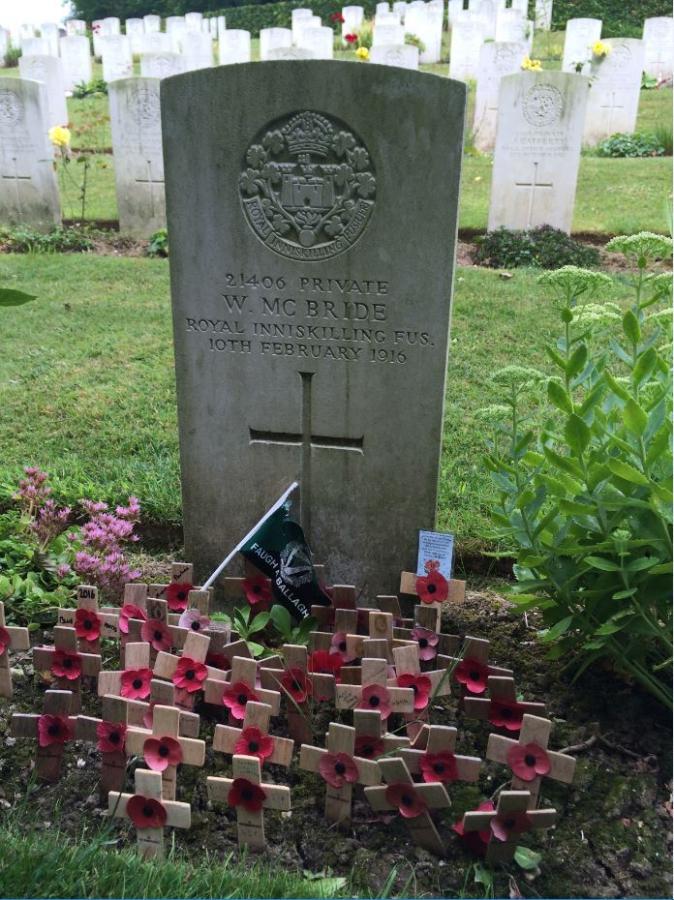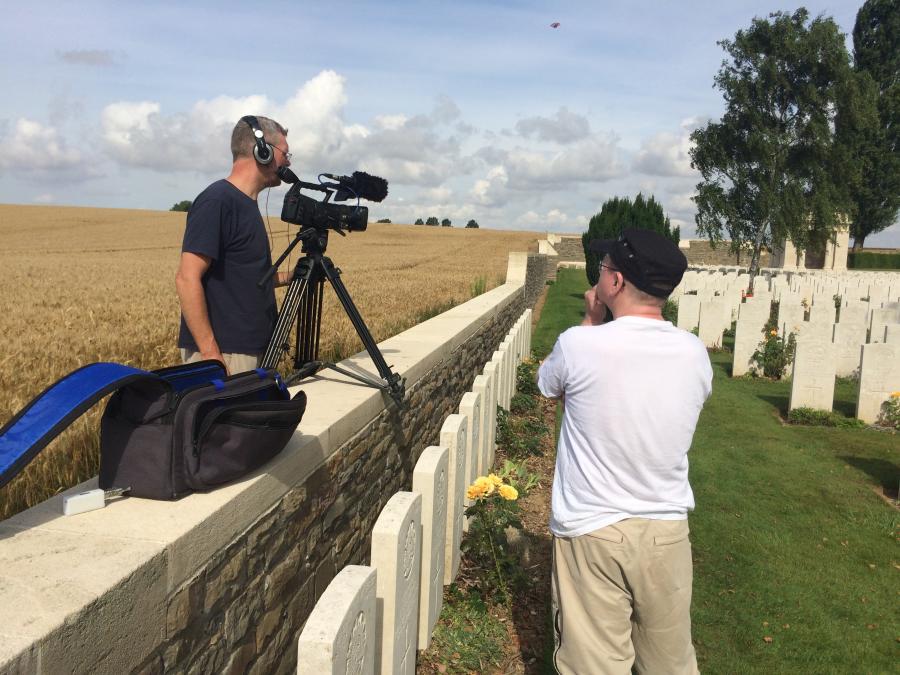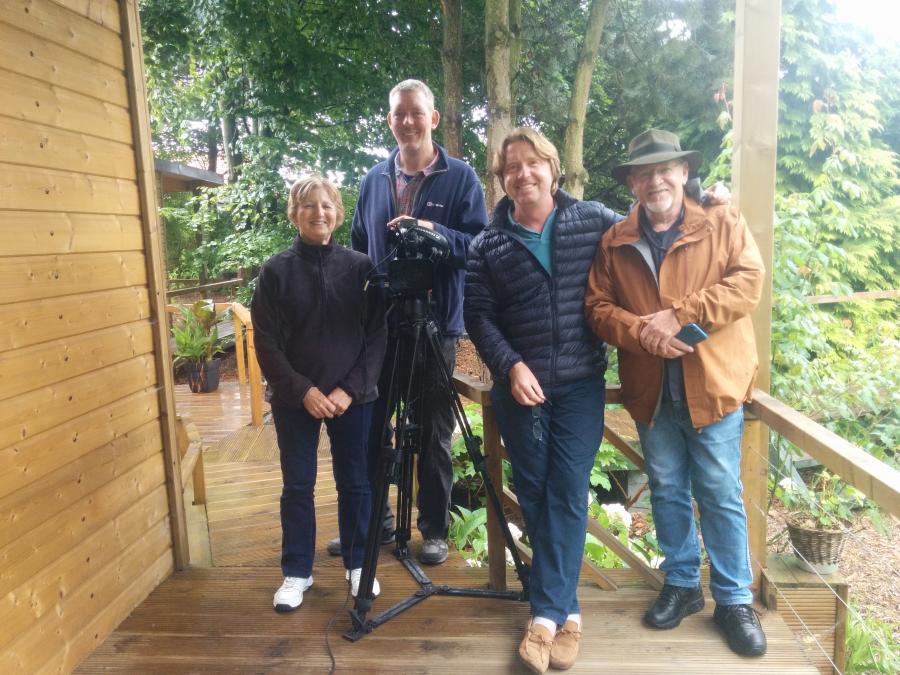Return to no man's land

‘Although you died back in 1916…’: The grave of W. McBride, Royal Inniskilling Fusileers.
It’s a place Eric Bogle has returned to time and time again, but he will never forget the first time he visited the Western Front battlefields that inspired his anti-war classic, No Man’s Land, more than 40 years ago.
“It just struck me how young they all were,” the singer-songwriter said from his home in Adelaide.
“In contemporary photographs of World War One, especially when they’ve just come back from the front line or are in the front line … they are all unshaven, and dirty and unkempt, and they all look like old men … [but] the average age of the combatant … was about 19 … so they were very young men, and that was the thing that made the deepest impression of me, and that’s what really engendered the song.”
It was 1975, and Bogle was just 31 at the time.
“I felt like an ancient grandfather walking among some of the gravestones,” he said. “And I came across a small French cemetery just outside the battle zone: two French drummer boys, 15 years old, killed on the same day, probably by the same shell, and buried in the same cemetery. Terrible.”
Deeply moved by the experience, Bogle returned to his hometown in Scotland to write. The result was No Man’s Land with its poignant tale of Private Willie McBride and the tragedy of war. It has been recorded numerous times since and has now inspired a documentary film, Eric Bogle: Return to No Man’s Land, which will premiere at the Australian War Memorial on Friday, 2 February 2018.
Shot by Dan Frodsham and Liam Tully in France in July 2016 during the 100th anniversary of the battle of the Somme, the film captures the moment Bogle revisited the grave of Willie McBride in Authuille Cemetery and recited the lyrics of No Man’s Land.

‘But here in this grave yard it’s still no man’s land’. Dan Frodsham and Liam Tully filming at the Somme, 2016.
“[It's a] place … that never fails to move me and inspire me,” Bogle said of the battlefields.
“I’d been there a few times before, so I knew what to expect. I knew the feeling of melancholy, and anger, and frustration, and all that sort of stuff that would come. It always does. You can’t walk those places and go to these memorials and cemeteries without being very moved, emotionally moved by it, and feeling angry as well at the waste of it all.
“[But] it’s an inspiration … to see the depths of human courage and sacrifice. When you are there, and you see the actual physicality of the battlefields – where they’ve fallen and just how close they were to each other – it reinforces … not your faith, but your hope in human courage, and generosity, and courage in the face of adversity.
“You can question the cause they were fighting for … You can question anything about it, but you can’t question the love they had for each other, and the sacrifice a lot of them made for each other, and that’s the finest of human characteristics really in some ways … so that is uplifting.
“There’s an amazing mix of emotions, but one of them is … just an uplifting belief, a reaffirmation that there are some things worth fighting for. So that’s why I think I visit [the battlefield], but having said that, the Somme experience last year was the last … I’ve been there about six times now and you can only go to that place so many times … before you reach emotional blowout … so I won’t be back … and I’m sure the boys lying there will be quite grateful for that.”
To Bogle’s surprise, the grave of Private William McBride, of the Inniskilling Fusiliers, has become something of a pilgrimage site, despite his insistence that the song is about all soldiers.
“I keep telling people [the name] was chosen at random because I can’t be bothered going through the whole story again, but it wasn’t really random,” he said.
“When I wrote this song, the IRA mainland bombing campaign in the UK was in full swing, [and there was a] very strong anti-Irish feeling, especially in England, but in the UK generally … McBride is generally a northern Irish name, and there were a lot of northern Irish boys joined up and fought and died for King and Country, so I thought it was a gentle reminder … I thought I’ll have a little gentle poke at people … It was just a little point to be made.”
Bogle, who was born in Peebles, Scotland, in 1944, wrote his first anti-war song, And the band played Waltzing Matilda, after he moved to Australia in 1969 and saw his first Anzac Day march while working as an accountant in Canberra in 1971.
“The Vietnam War was still going on at the time, so there were lots of protests going on and it wasn’t nearly as well covered and as well attended and well regarded as it is today,” he said.
“I’d got involved in Australia shortly after I got off the boat in the moratorium movement against the Vietnam War, and that’s when I wrote And the band played Waltzing Matilda, which was the earliest of my anti-war stuff… Even then, before I visited the Western Front, I felt an empathy and a sympathy for the ordinary soldiers who died in their millions to preserve a dubious future.”
Bogle never blamed the soldiers for the wars in which they fought.
“The song, And the band played Waltzing Matilda, was an anti-war song, but it wasn’t anti-soldier,” he said. “It was an attempt to be some sort of tribute to their courage and sacrifice, and make, hopefully, an anti-war statement … and that theme really continued with not just Willie McBride but also a few of the other … songs I wrote about war, about innocence lost and life’s sacrifice for dubious causes, and that’s been the theme. It’s never been anti-soldier… How can you blame poor young men who are drafted to go and fight a war they didn’t want to fight anyway?
“I’m not a pacifist, but I’m anti-war, and there is a difference … During the Second World War the boys realised that fascism just had to be stopped in its tracks or the world was doomed … So anti-war, yes, I am, but as long as there are people like Hitler that are born in this world … we have to try to stop them, otherwise we go backwards.
“People seem to think I’m some sort of idiot saying, ‘Oh, don’t hurt each other,’ but I’m not – I’m Scottish for God’s sake.”
Eric Bogle: Return to No Man’s Land premieres at the Australian War Memorial on Friday, 2 February 2018. The documentary film was designed to complement Michael J.K. Walsh’s book Eric Bogle, Music and the Great War: An Old Man’s Tears (Routledge, 2018). Both were funded by the Singapore Ministry of Education and Walsh will present a talk before the film screening.

Eric and Carmel Bogle, Dan Frodsham and Michael Walsh on location at Le Clos du Clocher, Gueudecourt, 2016.
Photos: Courtesy Michael J.K. Walsh